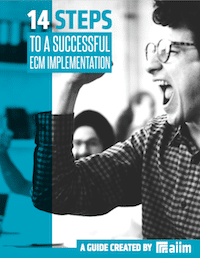The AIIM Blog
Keep your finger on the pulse of Intelligent Information Management with industry news, trends, and best practices.
Management had a chat and the robots start next week: Do you… Fortify the office to defend against the Robot Uprising–You won’t go down without a fight, right? Repress your inner cave-dweller, and find a way to leverage this new tool to more effectively manage digital documents throughout their lifecycle and delegate manual tasks? If you chose A: Best of luck! If you chose B: You are lightyears ahead of the people choosing A— feel good about that. You are also absolutely right:
Share
Accounting and Finance | Automation
If there was ever an industry in need of automation, it would be the mortgage lending industry. This industry is plagued by time-consuming and error-prone, paper and labor-intensive processes, front-end systems that do not communicate efficiently with back-end systems, and third-parties that are often not integrated into the process electronically. These problems are exacerbated by the huge volume of loans that are generated each year (nearly 5 million new consumer mortgages alone). Content management is a key enabling technology in solving these problems.
Share

Making an ECM implementation successful requires planning and attention to detail. The best way to create the right solution is to identify organizational goals and priorities. Learn how to manage a successful implementation in our free guide.
Accounting and Finance | Automation
According to the American Productivity and Quality Center, an amazing 74% of organizations are currently engaged in a finance process improvement initiative. Why are they doing this? And how does this tie to broader Digital Transformation initiatives?
Share
Accounting and Finance | Automation
This is the second of three posts on the theme -- CFOs and Finance Directors: Neglected Players in the Drive for Digital Transformation. The first post was here. The core point of the three posts is the financial process automation creates a value stream in two directions. It is a proven source of cost reduction for companies looking for marginal but sustaining competitive advantage, something that Finance Directors can use to "manage up" in their organizations in making a case for resources to drive financial process automation, which is the focus of this post. Financial process automation also creates the foundation for sound analytics and business intelligence, a priority of great concern to the C-Suite, which will be the focus of the third post.
Share
Automation | Document Management | Human Resources
It is the best of times and the worst of times for HR professionals. Many organizations have reaped enormous benefits from more effectively managing the unstructured information association with core Human Resources processes. That’s the good news. The bad news is that MOST organizations have not yet moved down the path of HR automation, creating massive inefficiencies and risks in their hiring, retaining, employee servicing, and firing practices.
Share
Automation | Document Management
All organizations produce documents, some even hundreds or thousands a day. Information contained in these documents is often vital to business – from producing sales quotations, policy, and procedure documents to employment or legal contracts. While some content in these documents will change, other aspects, such as its structure and how it is formatted, may not. In other words, many documents contain repetitive content that changes little from one document to the next and variable content that must be accurately personalized. Document automation can streamline the creation of the simplest or most complex corporate document, but many companies are confused by how it works. Below are five myths organizations need to think about when considering how they handle document creation.
Share